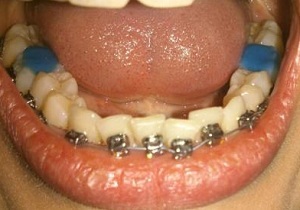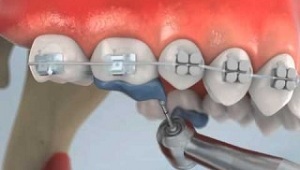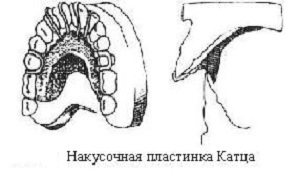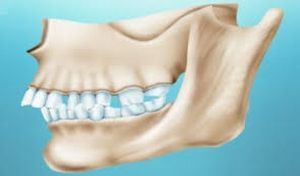 Uneven teeth are not only a problem of the appearance of a person, but also a purely medical defect, since an incorrect bite can lead to a number of pathologies, including abrasion of the tooth enamel, digestive disorders and other unpleasant consequences.
Uneven teeth are not only a problem of the appearance of a person, but also a purely medical defect, since an incorrect bite can lead to a number of pathologies, including abrasion of the tooth enamel, digestive disorders and other unpleasant consequences.
To fix the bite, complete with braces, so-called over-fillings or plates are used.
Contents of
- General description of
- Principle of operation
- Design features of
- Varieties of solutions and materials
- When applied?
- Therapeutic effect
- What determines the choice?
- Installation and care for the product
General description
Over-fillings are an integral part of the bracket system, which is installed to align the dentition and correct bite defects.
The plate, in fact, is a temporary seal of large caliber. It is installed on the upper or lower teeth that carry a chewing function, depending on which particular problems of the dentition need to be eliminated.
The bite plate has a special platform, carved with a certain angle of inclination. As a result of wearing such plates, the separated teeth are closed, and the bite is gradually corrected.
Principle of operation
Biting plates prevent complete closing of the upper and lower teeth during the chewing act with the braces installed. Their action is designed to: 
- with the braces installed to reduce pressure on the jaw and molars, that is, the teeth on the right and left sides of the jaws, which have a major role in the chewing process;
- reduce pressure on the bone structure and soft tissue near the teeth, which significantly reduces the risk of inflammatory periodontal disease, caries, enamel damage;
- protect the entire structure of the braces from displacement.
When installing fillings, the patient tends to experience some discomfort, due to the inability to completely close the jaw while chewing, but the unpleasant sensation soon passes.
Design features of
Most of the over-plates consist of:
- over-the-counter platform, which is designed to ensure the disengagement of the dentition in the correction area;
- of the labial arc connecting the clamps;
- metal clasps, fixing the plate in the mouth.
These designs differ depending on the type of plates. All of them have a support for the front teeth, the upper sky. If necessary, some models can be removed.
In some cases rubber thrusts are used instead of metal clasps, or the lip arch is attached to the molars using special rings.
Varieties of solutions and materials
There are two main types of over-fillings.
- Model of Katz .This is a design of the classical type, which has a support for the front teeth, the plate is fastened with loops and clasps.
- Model by the Khurgina .This model is equipped with rubber traction.
 Baking plates differ in the materials used in the manufacture of the product.
Baking plates differ in the materials used in the manufacture of the product.
The materials from which fillings are made are designed to protect the teeth from damage, so they must be both strong and non-aggressive to the enamel. There are a number of materials from which the plates are made:
- Artificial dentin .The seal is made of sulphate and zinc oxide, kaolin. When installed, this powder is mixed with distilled water, gradually achieving the required consistency.
- Dentine paste .The composition of the powder is approximately the same as that of the previous substance, but it is bred with clove or peach oil, which are necessary for antiseptic effect.
- Cement .This material is considered to be the most durable and durable. The lining for the tooth is made of polycarboxylate and zinc-phosphoric cements.
- Polymers .Consistency of this type of plate is similar to rubber. The seals of these materials are elastic and adhere well to the surface of the tooth. However, they do not require additional processing. Freezing is provided by means of a special lamp.
When applied?
The main purpose for the installation of an extra-fill seal is to eliminate the possibility of the tooth being bruised when chewing.
Sometimes they can serve to correct the location of the teeth if the degree of bite defect is not serious.
Very often, such seals are used in childhood, if the baby's teeth fall out earlier than usual, and this changes the bite. In dentistry, there are a number of other cases in which the installation of bite plates is shown: 
- the incommensurability of the lower and upper dentition;
- cross bite, that is, the displacement of the jaw bones relative to each other horizontally;
- deep bite;
- disharmony of the arches of the upper and lower jaws;
- contact of lower teeth with upper alveoli.
Plates most often do not require a long installation and application, quickly and effectively solving the problem.
Therapeutic effect
According to statistics, the therapeutic effect achieved with the use of these plates, in most cases allows you to correct the bite in three or four months. When corrected in childhood, this time increases to six months.
When applying seals, not only the problem of aesthetic nature is solved, but a number of other pathologies are corrected, namely:
- digestive system problems that occur when the chewing act is wrong;
- chronic neck pain;
- sprain of the jawbone;
- periodontal diseases, acquired as a result of increased pressure of the teeth on soft tissue during chewing;
- pain syndrome in the facial muscles;
- chronic migraine headaches.
What determines the choice?
The choice of a particular type of plate is performed by the dentist taking into account the individual characteristics of the body and the malocclusion anomaly and depends on:
- degree of prognathion, that is, the projection of the upper jaw relative to the lower one;
- the state of the patient's teeth;
- gum condition and susceptibility to periodontal disease;
- state of dental health;
- of the patient's age.

Installation and care for the product
When installing the plates, an impression is made, the health status of the teeth is assessed. It should be remembered that when installing such seals, some discomfort, felt when closing the teeth, is inevitable, but in case it is unbearable, it is worthwhile to see a doctor for correction.
In case the seals are placed on the rear parts of the jaw, they can be of different colors. From time to time they are corrected and replaced, because during the process of wearing them they can crumble and rub away. When there is no need for plates, they are grinded off by a drill.
Bumpless plates require special care and adherence to a number of rules in everyday life:
- removable plates are rinsed with water before dressing;
- once a week, the plates are disinfected in a special solution;
- teeth cleaning should be done with a soft brush and a special paste that the dentist will advise;
- for storage of seals, special containers are provided;
- it is desirable to use a special gel that eliminates bacteria and neutralizes bad breath;
- at sports loads it is required to remove plates.
Biting plates in some cases are not only necessary, but also an unavoidable measure used for correction of occlusion.
